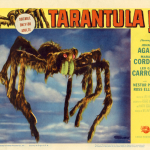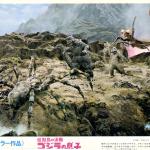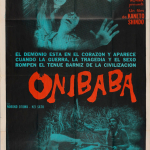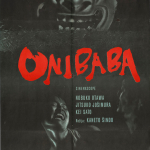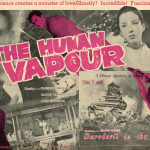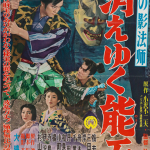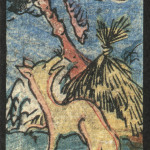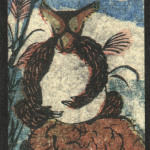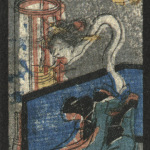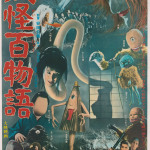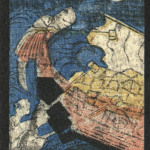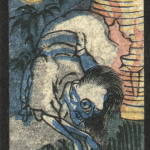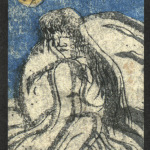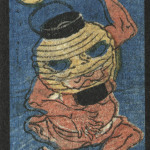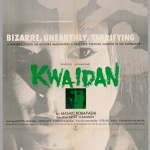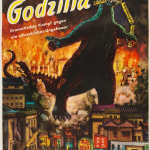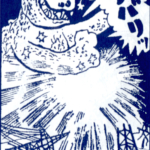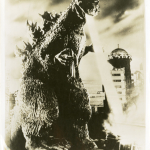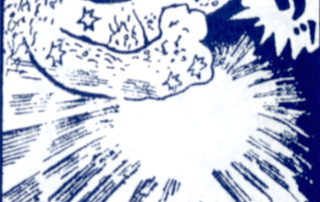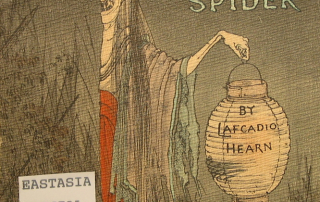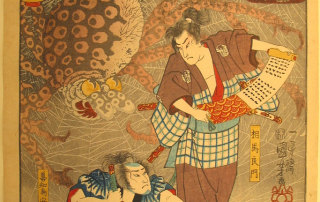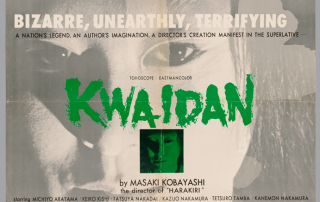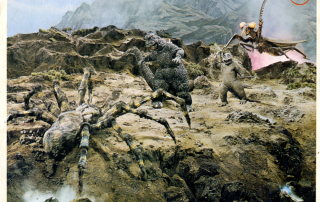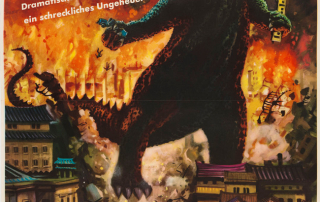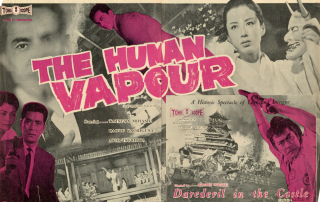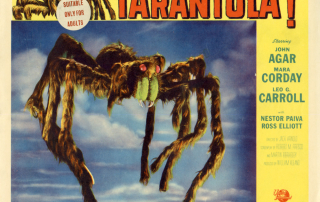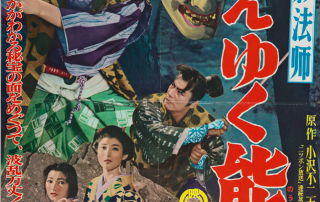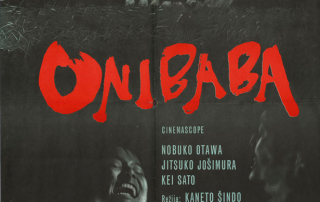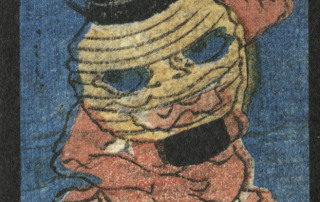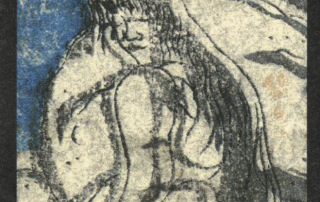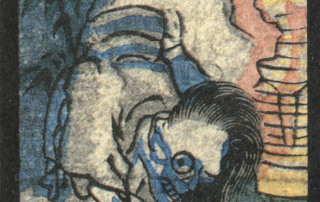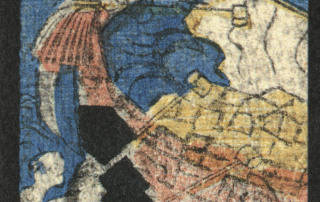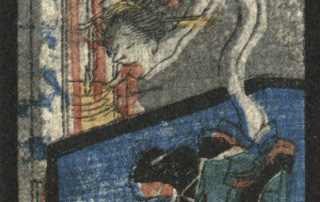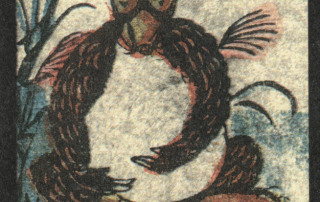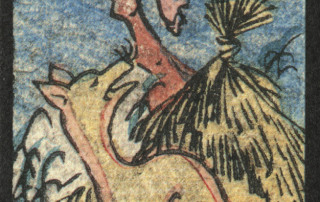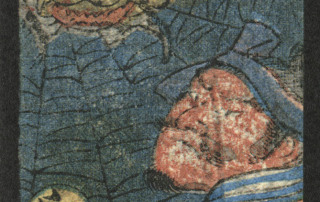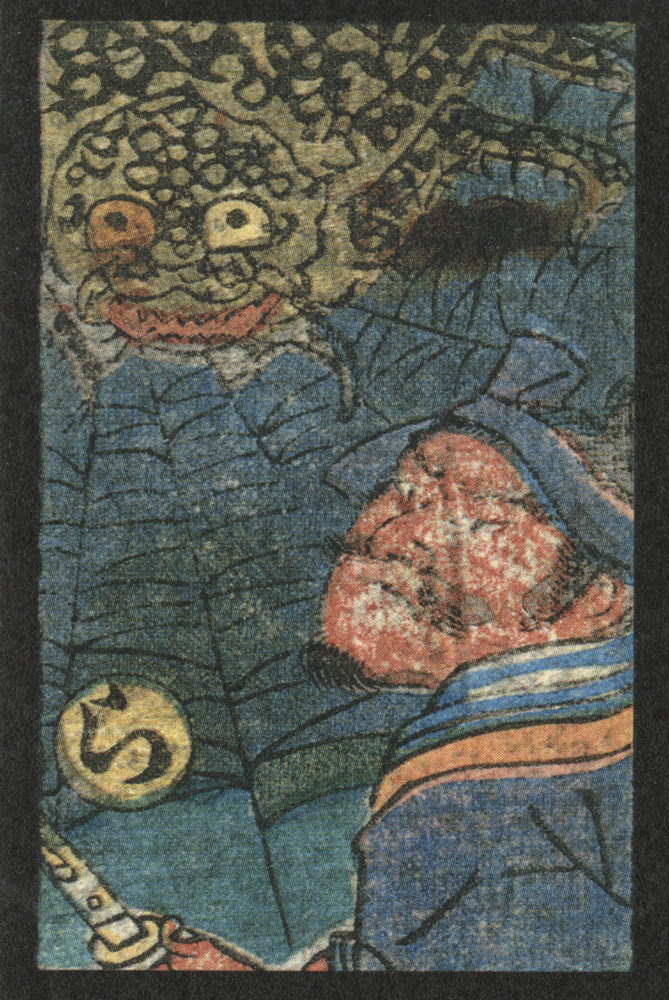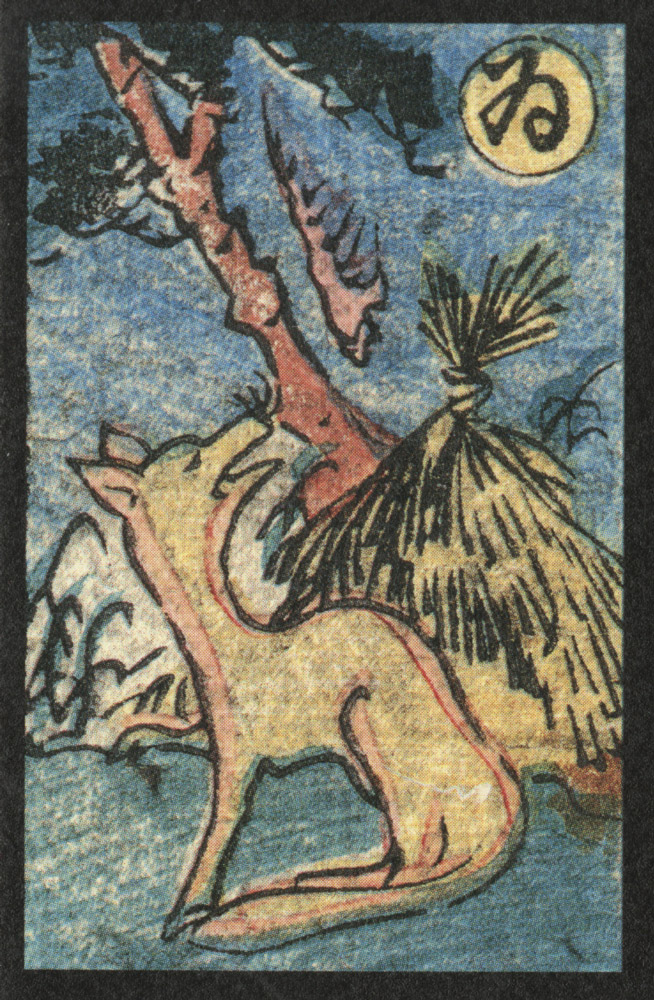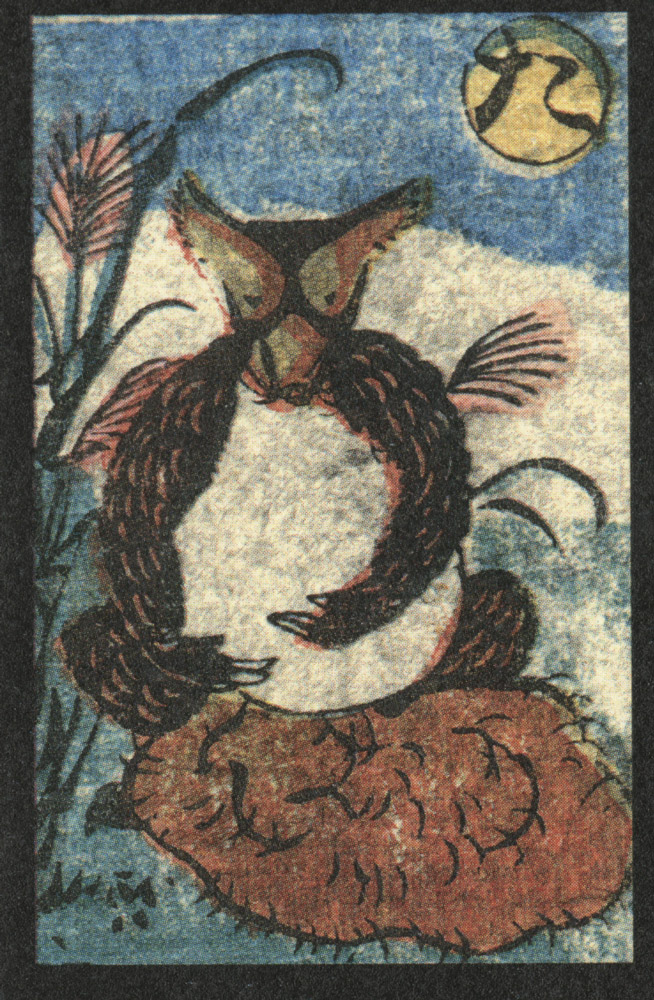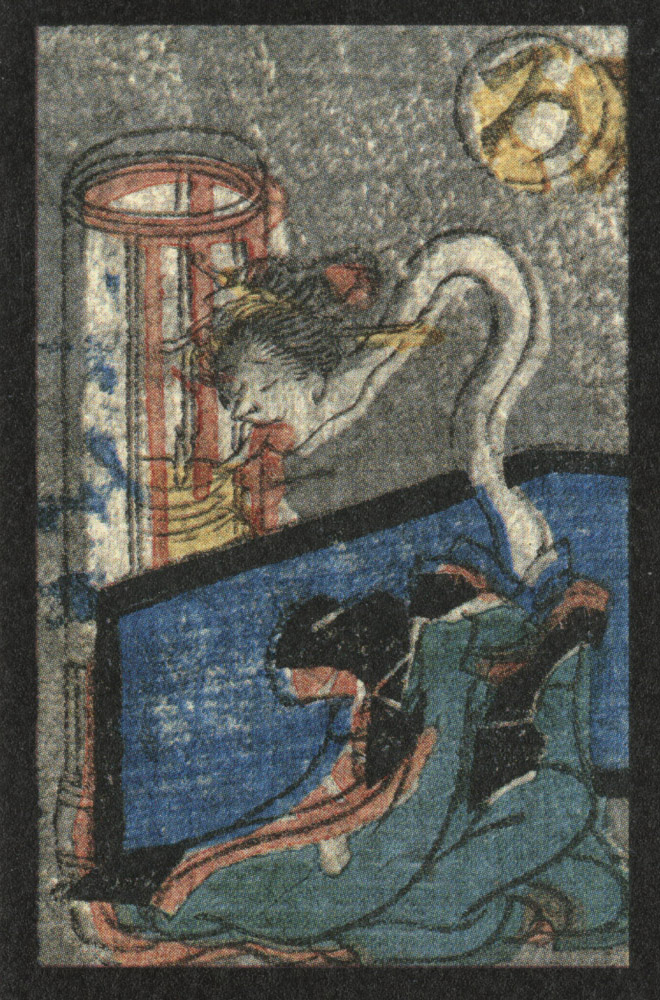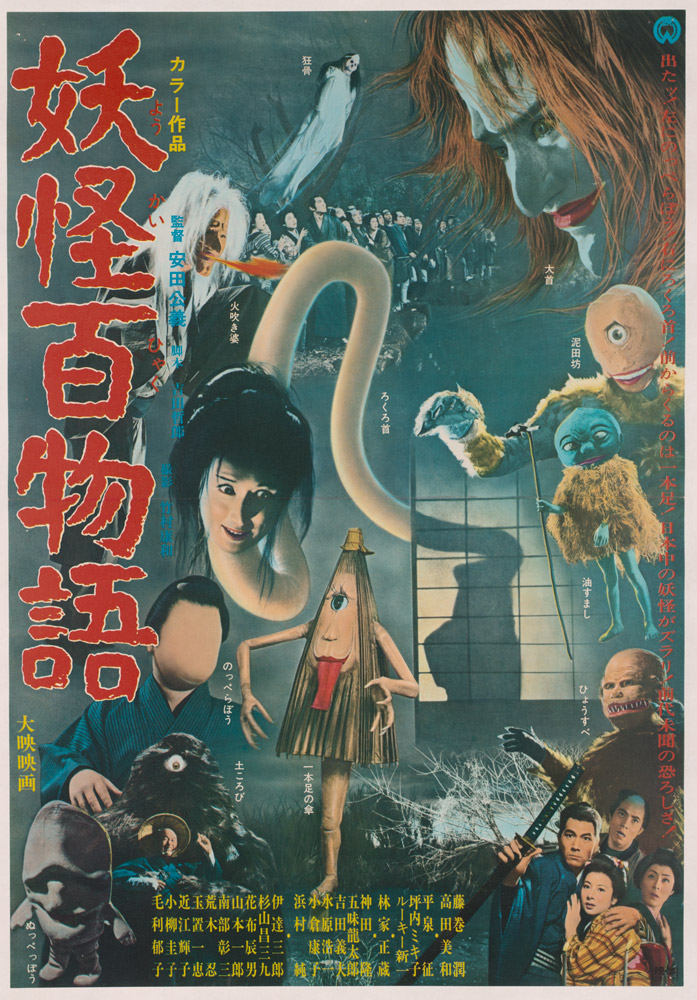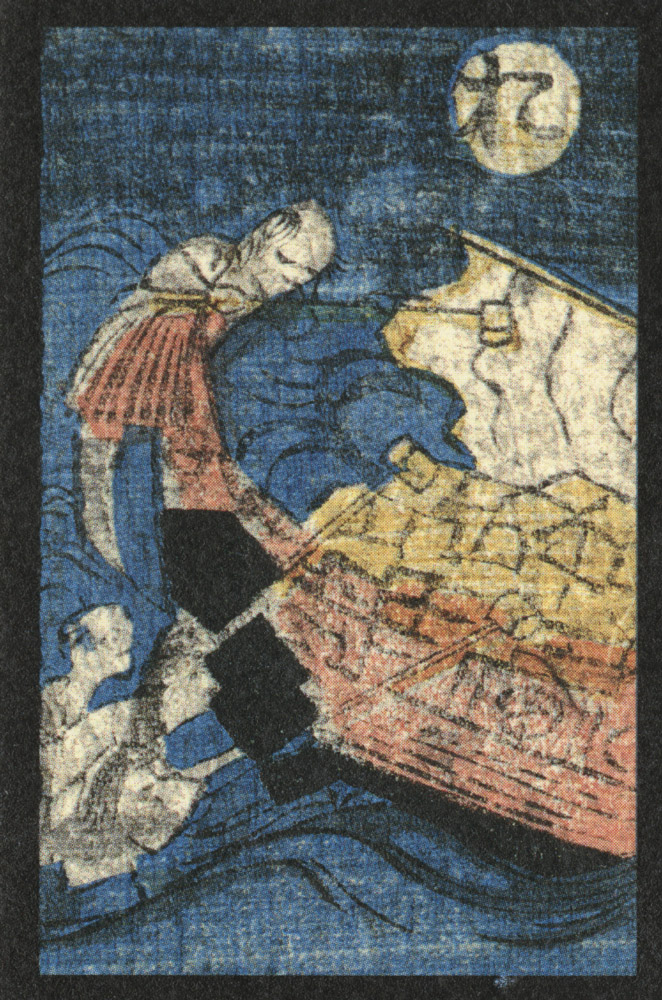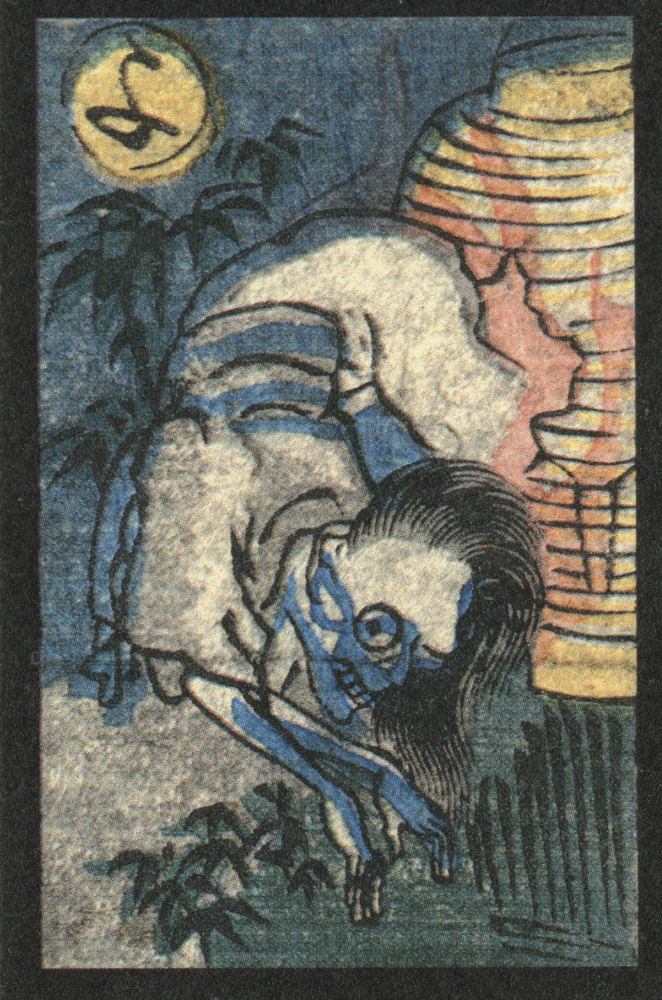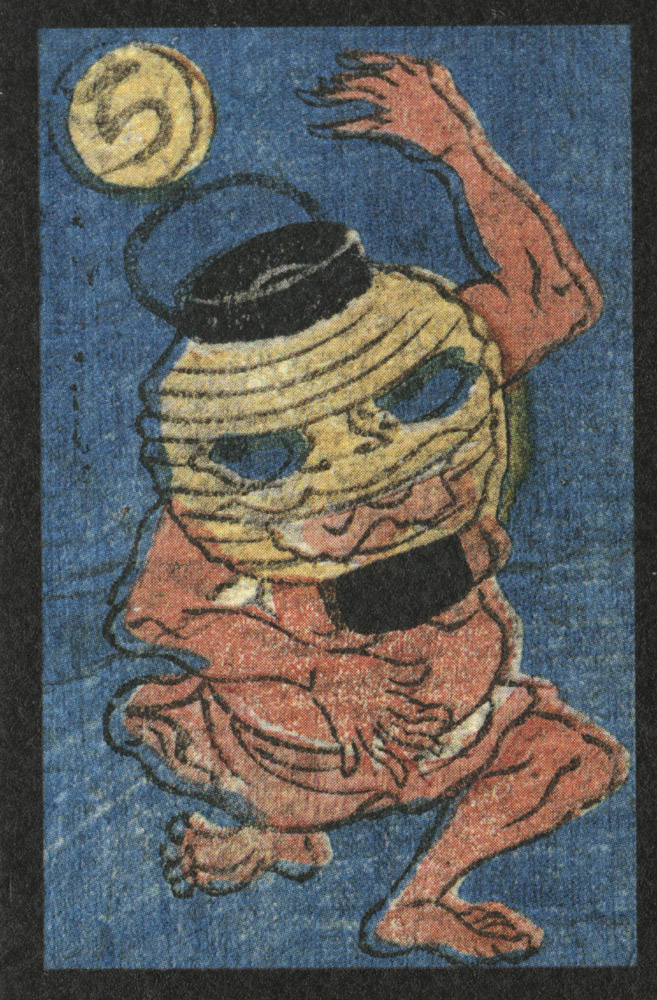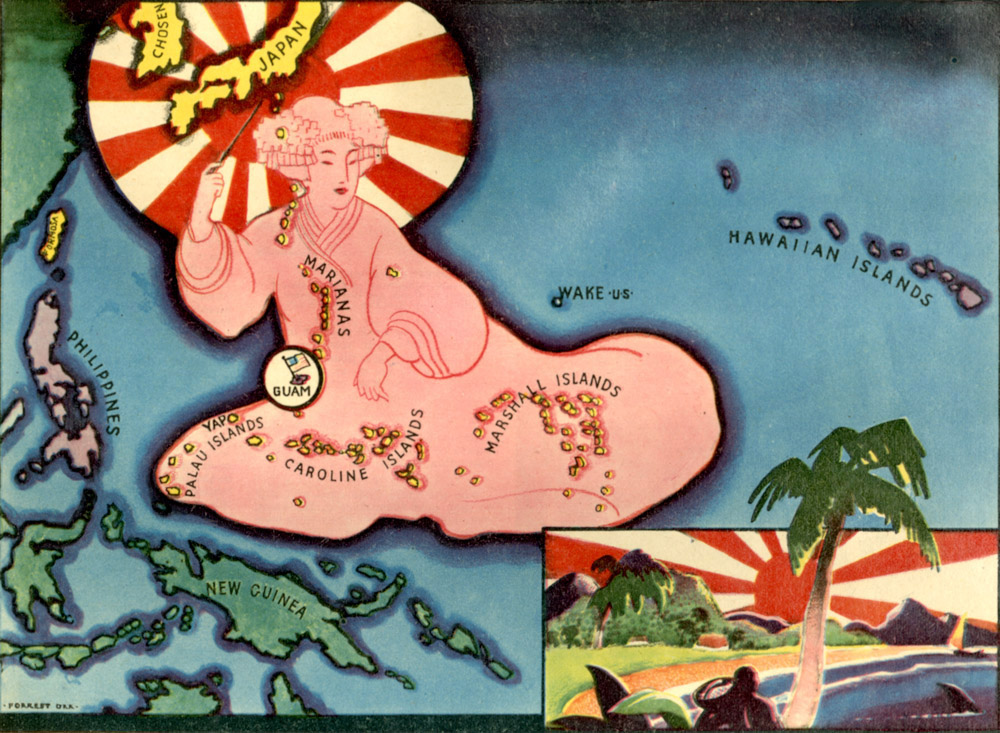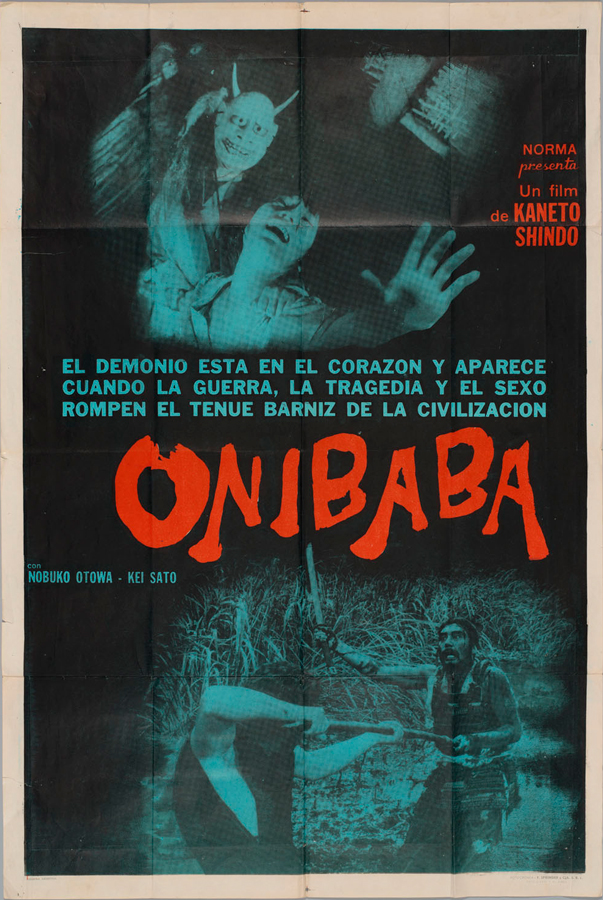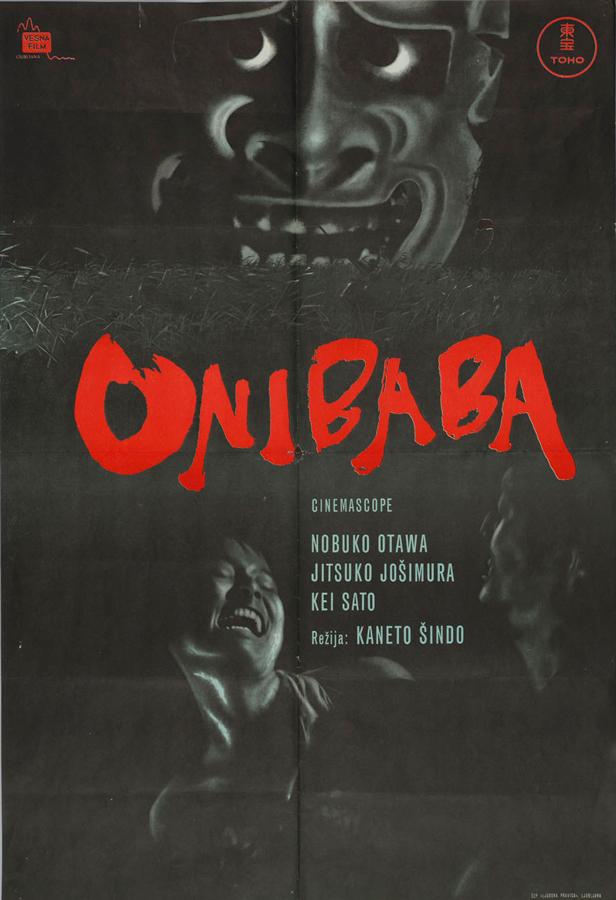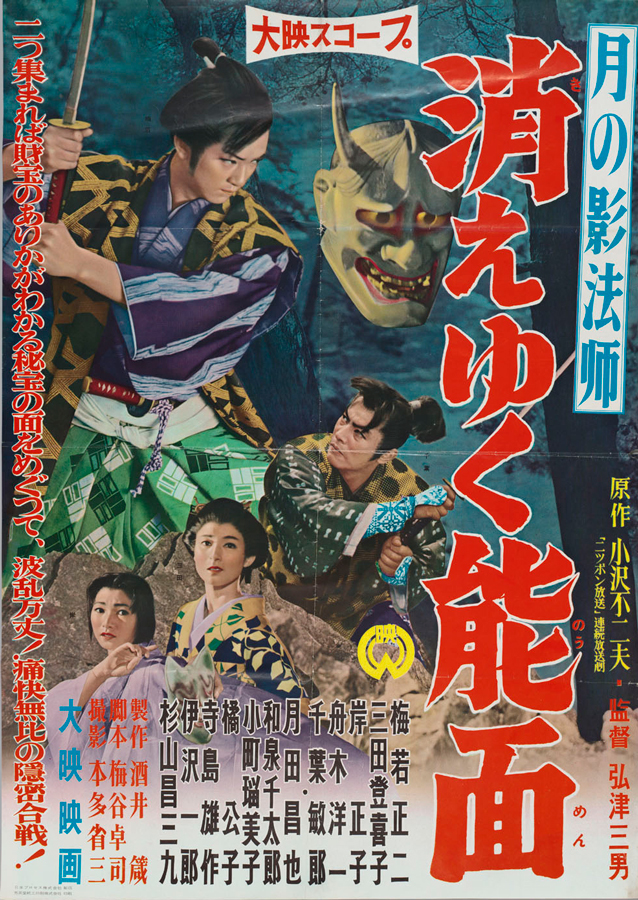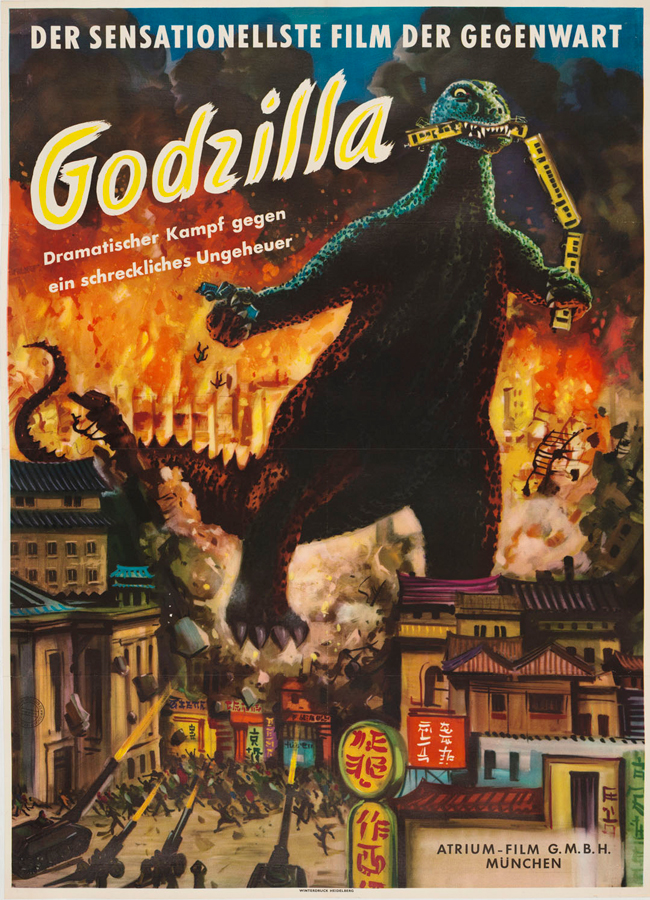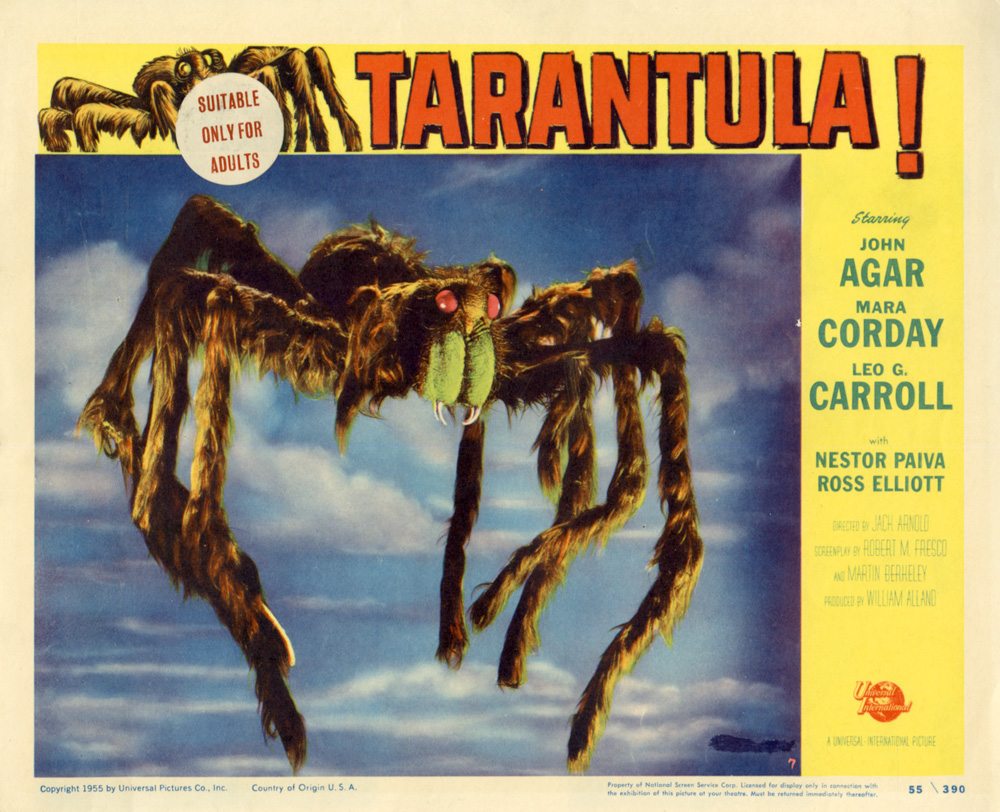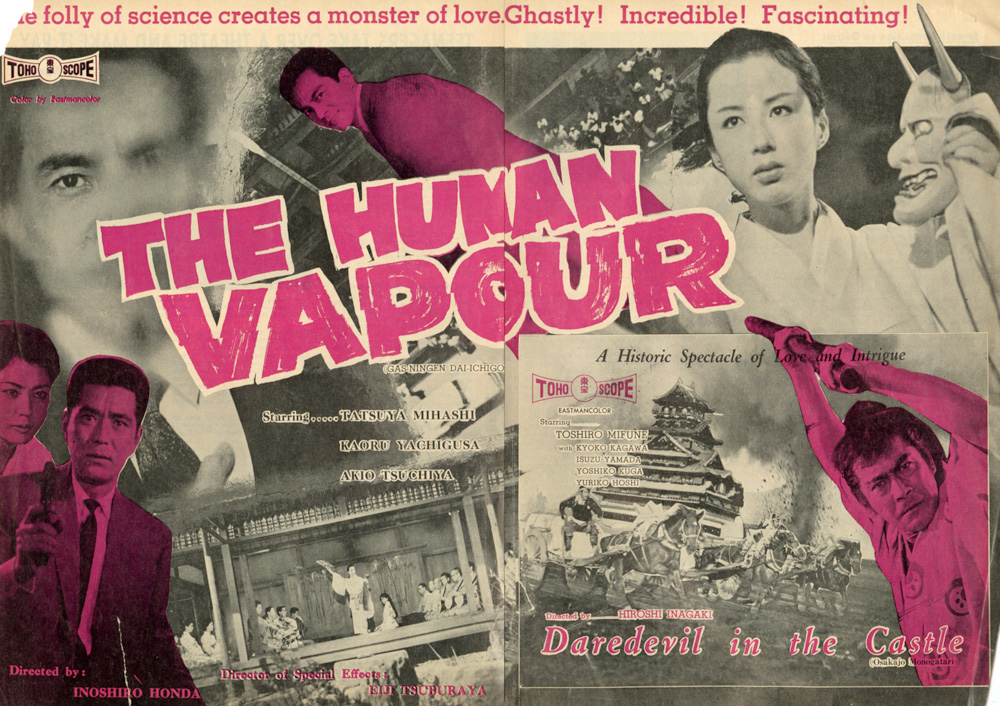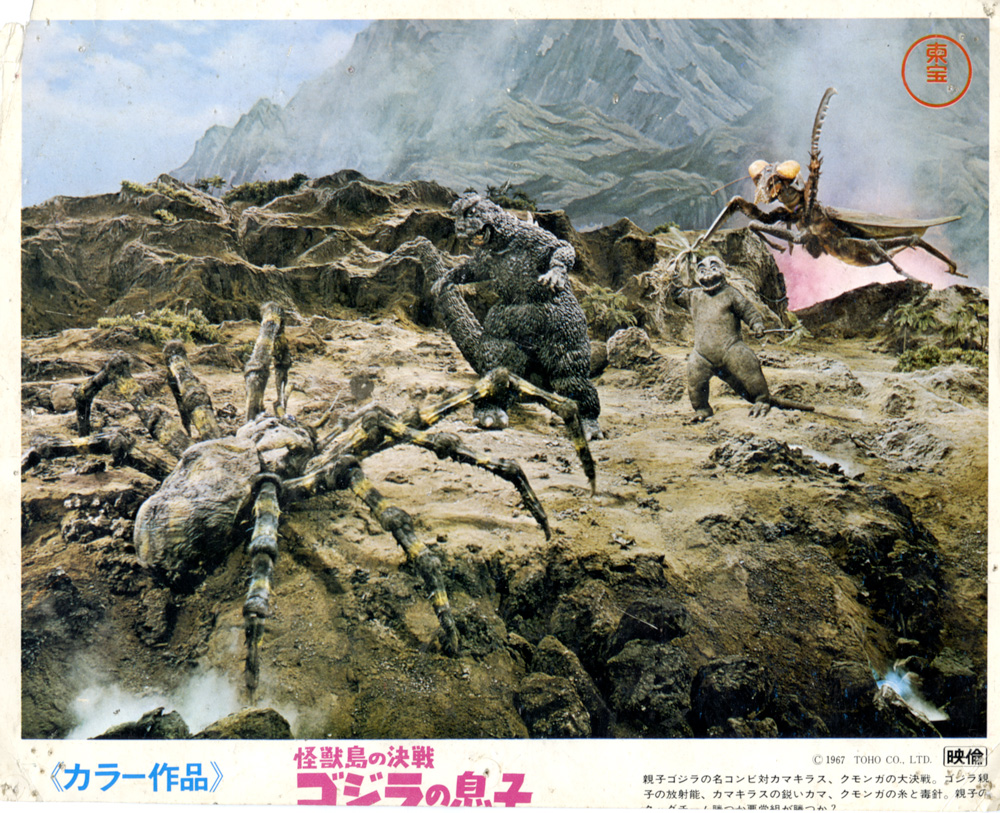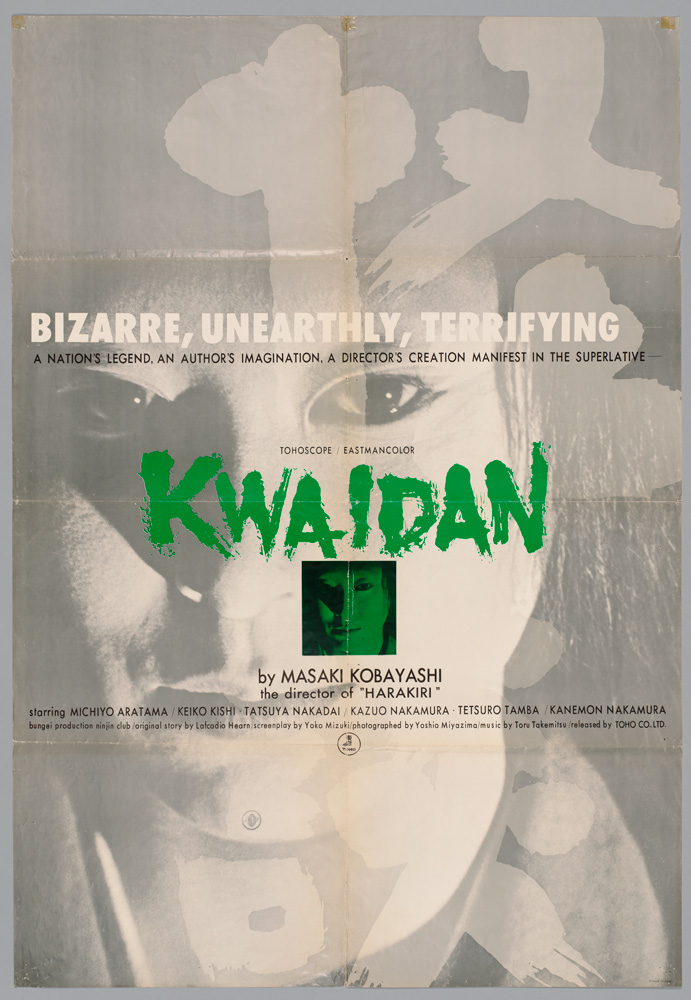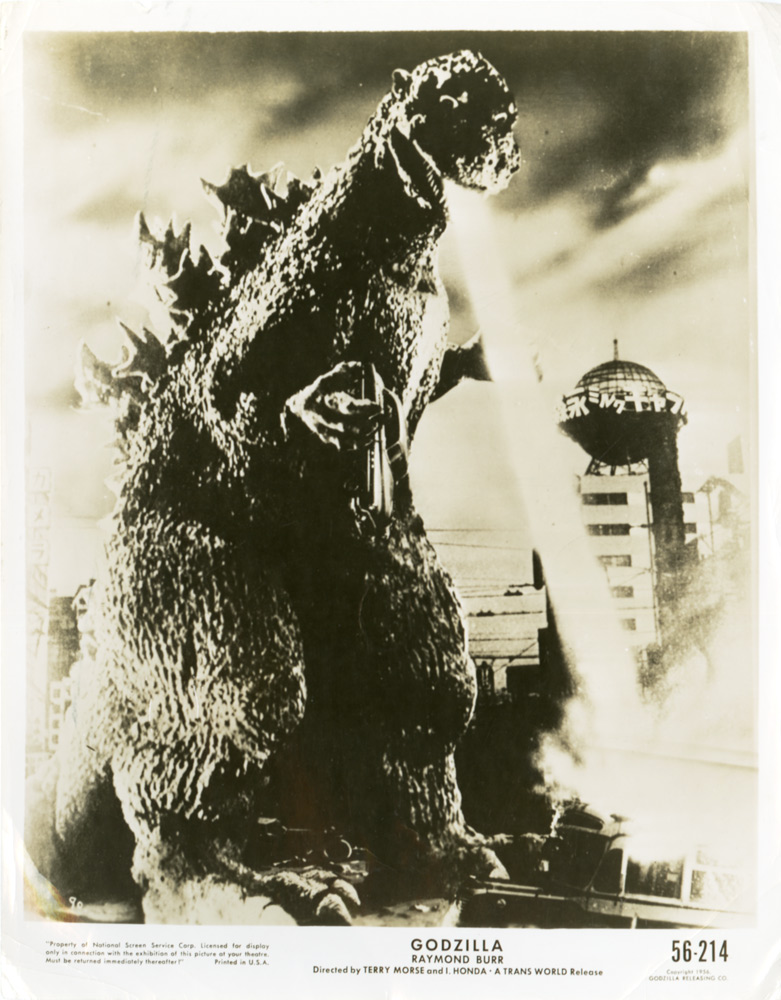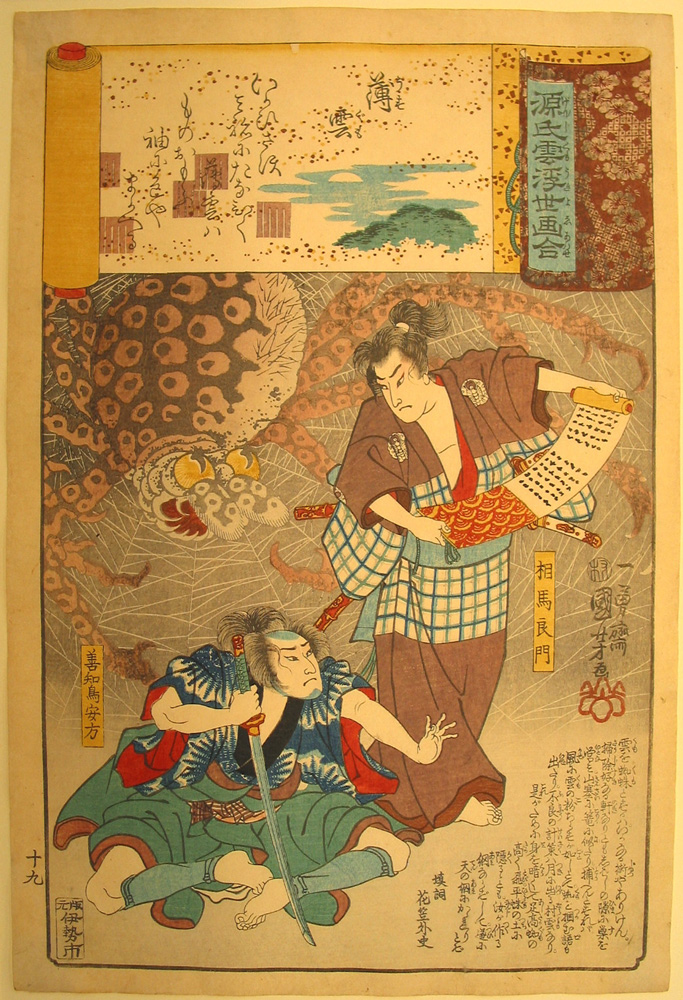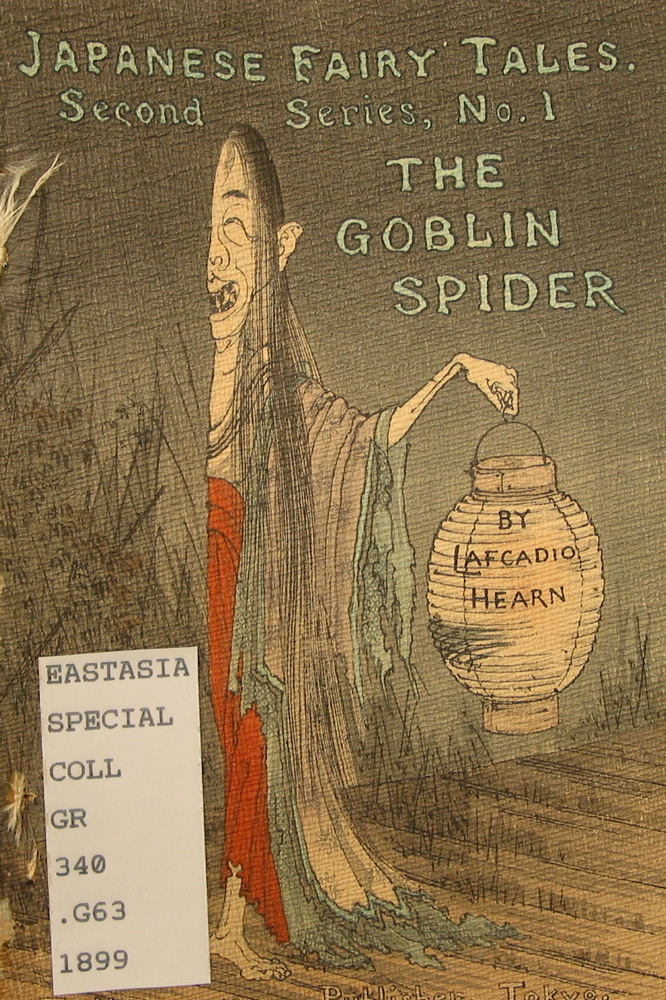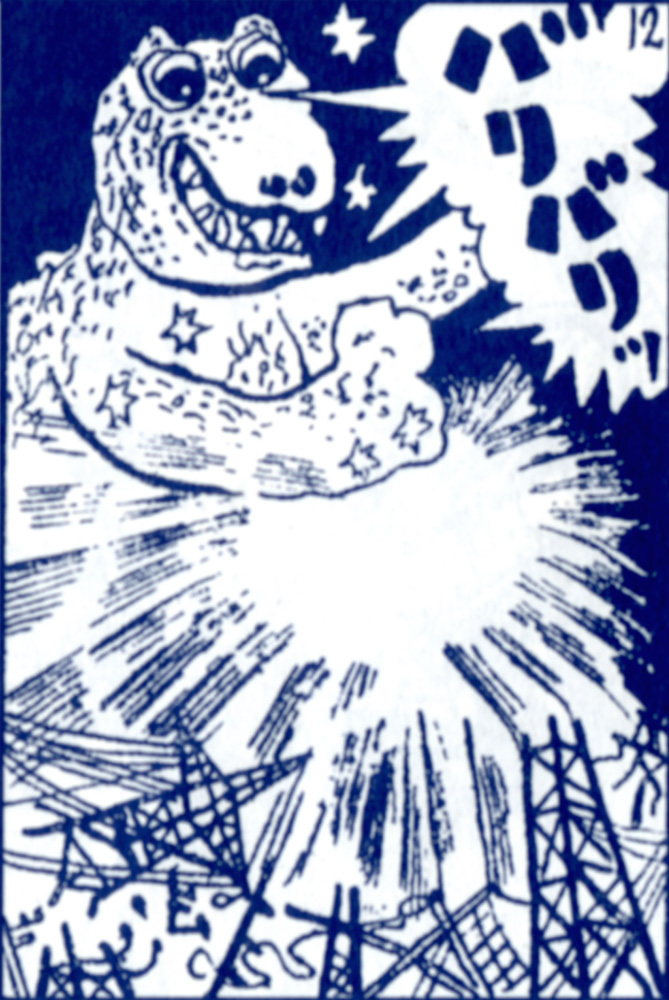CONTINUED FROM MODULE 2 PART 3
MONSTER CULTURE AND MONSTER COMMERCE
Much as Godzilla is part of film history, movies are part of a broader history of images, beliefs, and cultural practices surrounding monsters and other fantastic beings around the world. In Japan, that history, at least as far as it’s recorded, extends back over a thousand years, long before celluloid was ever invented. Japan’s oldest surviving writings, the imperially commissioned chronicles of the eighth century, incorporate a number of oral legends about creatures that in certain respects resemble modern kaijū, whether because of their threatening nature, their fearsome strength, or their animal-like shape. The Buddhist religion, which entered Japan from the Asian mainland in the sixth century, contributed its own cosmology of heavenly beings and frightening demons to this mythological menagerie [VISUAL SIDEBAR 8: Creatures Old and New]. Just as pagan beliefs and Christianity combined in Europe to shape Western ideas about ghosts and monsters, Buddhism and kami worship (Shinto), coexisting peacefully over the centuries, exerted a powerful influence on folk understandings of the supernatural in Japan.
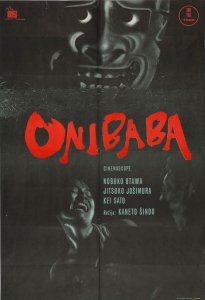 The figure of the kaijū, or made-in-Japan movie monster, was, and could only be, a twentieth-century invention. Not only did the scientific trappings of the kaijū suit this particular breed of monster for an age of religious skepticism and technological development, but the manner in which kaijū imagery circulated—primarily via film and television—was through mass media that only came into their own during the twentieth century.
The figure of the kaijū, or made-in-Japan movie monster, was, and could only be, a twentieth-century invention. Not only did the scientific trappings of the kaijū suit this particular breed of monster for an age of religious skepticism and technological development, but the manner in which kaijū imagery circulated—primarily via film and television—was through mass media that only came into their own during the twentieth century.
As far as subject matter is concerned, though, popular culture seldom creates anything out of whole cloth. More typically, it recycles and refashions existing threads. For well over a millennium before Godzilla’s birth, Japanese artists and storytellers had woven a rich tapestry of monstrous images. No matter how modern or futuristic the kaijū eiga genre and its settings may have looked at the time, its creators drew upon, even as they reshaped and helped to perpetuate, some of these older traditions. Even a cursory glance at Japan’s monster history reveals both continuities and transformations.
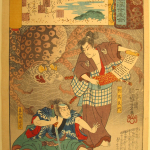
Figure 2-08-001
One of the oldest monster traditions in Japan is that of the “earth spider” (tsuchigumo), a creepy entity that appears in the imperial chronicles of the eighth century as well as in many later works of Japanese art and literature. The word itself didn’t originally designate actual crawling critters, but instead a group, or perhaps groups, of humans who lived in pit dwellings—not unlike burrowing spiders—and resisted imperial authority. This woodblock print (Fig. 2-08-001), by UTAGAWA Kuniyoshi (1797–1861), one of the medium’s masters, dates from 1845 or 1846. It depicts two tenth-century warriors, along with one of the men’s late sister, who has returned to life as an enormous earth spider. Like other woodblock artists, Kuniyoshi drew a good deal of his material from the popular stage. The scene recreated here was a favorite among both puppet theater (bunraku) and kabuki audiences, partly because it lent itself to impressive special effects.
In the cinema era, the tradition of the “earth spider” got a new lease on life from the 1967 release of Son of Godzilla (Fig. 2-08-002). Tōhō’s eighth entry in the Godzilla series introduced viewers to Kumonga, a kind of giant burrowing spider that lives on a tropical island and puts up a vicious (and viscous) fight against Godzilla and his offspring. To approximate the name Kumonga—kumo is the Japanese word for spider—the American (AIP) TV dub of 1969 called the new kaijū species Spiega, meant to rhyme loosely with the English word “spider.” Whether as Kumonga or as Spiega, the arachnid star had a name to call his own, unlike his counterparts who had appeared in such Hollywood sci-fi classics as Tarantula (1955; Fig. 2-08-003) and Earth vs. the Spider (1958; billed simply as “The Spider” in markets like France [Fig. 2-08-004]). Kumonga inherited a distinct identity—if not exactly a lovable personality—from the cultural lineage of the “earth spider,” whereas Hollywood filmmakers treated their own giant spiders as little more than zoological specimens. The kaijū spider Kumonga appears at the left side of this Japanese lobby card (Fig. 2-08-005), together with (moving rightward) Godzilla, his son Minilla, and a mantis-like Kamakirasu, one of the island’s other buggy inhabitants.
Kumonga’s name also echoes Japanese monster tradition in a second way that has little to do with bugs. Although the English-language equivalent, Spiega, does a fair-enough job of communicating Kumonga’s arachnid identity, it can barely begin to capture the nuances of -monga, the name’s distinctive ending, which evokes a different species of animal. To Japanese ears, Kumonga rhymes naturally with momonga, a common noun meaning flying squirrel. Before anybody starts picturing the familiar bushy-tailed tree-scamperer, it must be pointed out that, for premodern Japanese, the flying squirrel—a natural glider, unlike the tree squirrel—was anything but cute. As night foragers who, like bats, might suddenly appear out of nowhere, Japanese flying squirrels were instead typically perceived as scary, to the extent that sneaking up to someone and shouting momonga was the equivalent of yelling “boo.” Kumonga’s original name thus combined the cultural resonances of not one but two fear-inspiring creatures of Japanese folklore.
The christening of Kumonga wasn’t the first time that Tōhō had turned to momonga lore for inspiration. Nor was it the first time that those associations had flown over the heads of overseas viewers. One of Tōhō’s earliest attempts at kaijū moviemaking, Daikaijū Baran (1958), had in fact grafted the characteristics of a flying squirrel onto those of a giant lizard in visualizing its title monster, Varan. Casting aerodynamic credibility to the winds, Varan’s creators insisted that the lake-dwelling and earth-rambling giant should also have the ability to glide hundreds of kilometers in a single bound. For Americans, who lacked any familiarity with momonga folklore or flying squirrels, this premise evidently taxed the zoological imagination, so that Crown International Pictures chose to edit all of Varan’s airborne scenes away.
Flying squirrels share the skies of Japanese folklore with a creature called the tengu, or winged goblin, whose name came originally from China and literally means “celestial dog.” Despite that moniker, tengu imagery in Japan developed in an avian rather than a canine direction. Japanese typically imagine tengu with long or beaklike noses, clawed feet, and a fondness for mischief. In 1639, one anonymous storyteller chose the long-nosed tengu as an aptly scary metaphor for describing the odd features of the first Caucasians who visited the archipelago: Portuguese Jesuits who had arrived in the middle of the sixteenth century and whom Japanese political authorities eventually expelled, along with most other Westerners, for fear of sedition. More often, Japanese folklore associated the tengu with mountain hermits who practiced a brand of Buddhist-Shinto eclecticism.

Figure 2-08-006
Rather than just having long noses like the tengu, twentieth-century kaijū are big in every dimension. Ironically, though, it’s the human-sized tengu and not the dinosaur-dwarfing kaijū that appears ahead of any other fictional creature in the Godzilla cycle. The Japanese monster that audiences first set eyes on in Gojira is not the giant character of the title but rather the mythic tengu, as represented in the kagura ritual of Ōdo Island. In a scene at the Shinto shrine on Ōdo (actually shot at Toba City’s Kata Shrine), roughly eleven minutes into the movie, a half-dozen kagura dancers whirl slowly in unison while sporting long-nosed tengu masks. Their lacquered masks closely resemble those worn to portray tengu in the noh theater (Fig. 2-08-006), a style of drama that arose historically in the fourteenth century.
Another masked monster of the Japanese stage was the oni or demon. Horns, rather than a long nose, are the oni‘s most striking facial feature, since in Japan as in Europe, the folk imagination conventionally pictured devilish beings with pointy growths on their foreheads. Examples of oni masks may be seen on various publicity materials for the 1964 film Onibaba, including posters and lobby cards from Argentina (Fig. 2-08-007), East Germany (Fig. 2-08-008), Mexico (Fig. 2-08-009), and Yugoslavia (Fig. 2-08-010). The title of the Japanese movie literally means “demon hag,” but in colloquial usage the phrase can refer to any elderly woman feared or despised by her neighbors. The lead character of Onibaba arguably deserves that label more than most, since she makes her living by trapping and murdering lost warriors then selling their armor and weapons. Like the 1959 docudrama Daigo fukuryū maru, 1964’s Onibaba was directed by SHINDŌ Kaneto and produced independently by his Kindai Eiga Kyōkai (Modern Film Association). Overseas distribution of Onibaba, however, took place through Tōhō, which enjoyed greater international exposure.
Onibaba‘s plot hinges on a demon-faced mask that resembles the sort used in noh drama, thus jibing with the picture’s fictional setting in Japan’s middle ages. The particular type of mask is called hannya, and conventionally represents a jealous female. Its symbolism reinforces one of the central themes of Shindō’s film, which is the uncanny power of female erotic desire and sexual rivalry. Written and directed by one of postwar Japanese cinema’s masters, Onibaba is not nearly as exploitative as the British double-bill poster (Fig. 2-08-011) might lead one to suppose. Nevertheless, in movie markets like the U.K. and Mexico, commercial promoters of Onibaba tended to emphasize the film’s erotic content over its esthetic merits, and even over its horror aspects.
Just as a bevy of long-nosed tengu masks prepares Gojira‘s audiences for goose bumps before they meet Godzilla himself, demon masks with horns set the tone early on for spookiness in two of Tōhō’s other special-effects features. Oni motifs are especially conspicuous in 1958’s Daikaijū Baran (1962’s Varan the Unbelievable), a movie that echoes Gojira in many other ways as well. Ōdo Island’s goblin kagura finds its equivalent here in a kagura ritual dominated by images of horned demons, or oni, as a boy character on his way to the ceremony identifies the frightening mask he wears. When we join a larger group of adult male celebrants at the village shrine (the scene shown above in Figure 2-01-002), their masks display, in addition to the telltale horns, a mane of shaggy hair, reminiscent of the namahage ogres of rural Akita, which lies not far from the movie’s fictional setting. Crown International’s 1962 Varan the Unbelievable preserved the kagura scene, and its American scriptwriter even took the oni motif a step further by dubbing the city where the final assault on Varan occurs (it’s Tokyo in the 1958 Japanese version) “Onida”—literally, Demonfield. An inside joke, the connection was surely lost on most American viewers.
Likewise, in 1960’s The Human Vapor (Fig. 2-08-012), viewers first meet the lead female character, a master of traditional Japanese dance, as she’s rehearsing her craft wearing a horned demon mask of the hannya variety. The striking image is reproduced in an English-language trade ad (Fig. 2-08-013) for the movie. Steeped in centuries of stage performance, the simple mask serves to inject a note of classical horror into a modern medium. In 1958, a similar prop had even starred in a horror picture of its own: The Disappearing Noh Mask (J. title: Kieyuku nōmen; Fig. 2-08-014), a period piece from Daiei studios. In The Human Vapor, the character with the hannya mask, KASUGA Fuchichiyo, is lover and muse to the movie’s criminal antihero, whom a diabolical scientific experiment has reduced to a gaseous state. It may be worth noting that the actress playing Kasuga, namely YACHIGUSA Kaoru (born 1931), was the wife of TANIGUCHI Senkichi (1912–2007), the veteran Tōhō director who was responsible for such films as Samurai Pirate (billed in the U.S. as The Lost World of Sinbad) and Key of Keys (the pre–Woody Allen version of What’s Up, Tiger Lily?).

Figure 2-08-015
In Japanese folklore, the figure of the oni is closely associated with the New Year holidays, in former centuries celebrated according to the lunar calendar. Akita’s namahage, for example, make themselves visible to humans just once a year at that time. Even today, many households in Japan scatter dried soybeans near the front door for luck to mark Setsubun, the beginning of the Lunar New Year. The ritual serves supposedly to exorcise the trouble-causing oni that have accumulated around the dwelling and the family over the previous twelve months, as reflected in a woodblock-printed book (Fig. 2-08-015) by KATSUSHIKA Hokusai (1760?–1849). This particular illustration appears in a work called Manga—literally, “Playful Pictures”—whose fifteen volumes Hokusai published serially (and in part posthumously) over the course of the nineteenth century, and which circulated widely among the Japanese populace. The name of Hokusai’s publication gave rise to today’s generic term manga, which refers to Japanese-style comic books and has entered the shared vocabulary of global pop culture.
Although demons had a bit more to worry about than other revelers, New Year’s and the period leading up to it—whether in solar or lunar terms—have long been a special season for Japanese monsters and their kin. With the publishing explosion that began in the seventeenth century, New Year’s, along with the Boy’s Festival of the fifth month, became a time when woodblock prints and books with monstrous themes would regularly be published, to the delight of many children. More recently, the winter holidays have become a popular time for motion-picture releases. Of the twenty-eight Godzilla movies made in Japan since 1954, it’s no accident that nearly two-thirds of them, or eighteen to be exact, premiered during the lucrative box-office month of December.
Yet to speak of the “supernatural” in this context—or in any historical context prior to the introduction of modern science—is, strictly speaking, an anachronism. It’s only the emergence of science, with its distinctive set of beliefs about what’s “natural” and what’s not, that allowed such categories as the “supernatural” and “superstition” to come into being in the first place. In Japan, that paradigm shift occurred in the late nineteenth century, during a period of vigorous interaction with Euro-American ways of thinking and cultural institutions. Before that time, most Japanese had regarded gods, demons, and monsters as part of the natural environment in which humans lived and carried out their daily business. That’s not to say that no one would have batted an eye if he or she encountered a winged goblin on the road. It’s only to suggest that the specifically modern form of consciousness that confines creatures like Godzilla to the realm of “science fiction” depends on an understanding both of “science” and of “fiction” that is relatively recent in origin.
For an eighteenth-century resident of what is now Tokyo, a winged goblin (tengu), a river imp (kappa), or a fox or badger in human form (bake-kitsune and bake-tanuki, respectively) wouldn’t have seemed supernatural so much as strange, which is to say, out of the ordinary, or remarkable. This realm of the strange—but plausible and in that sense “natural”—provided a favorite theme of folktales, written literature, and the visual arts in Japan throughout many centuries. It found expression in a word for monstrous creatures that began to appear with growing frequency around the eighteenth century: yōkai, the two constituent characters of which both mean strange or marvelous. The second character, kai (怪), which could also stand by itself, eventually found its way into the standard twentieth-century designation for Godzilla and other film monsters, namely, kaijū, or “strange beast.” An approximate synonym for yōkai in vernacular Japanese even today is bakemono, literally “transformed thing,” or shape-shifter, whether a nonhuman animal that has assumed the guise of a person, a material object that has become animated, or a living person who has turned into a disembodied spirit. As bakemono scholar Adam Kabat points out, however, many creatures thus described seem not to have undergone any particular change at all, so the category, like that of yōkai, is somewhat fuzzy at the edges.
 During the Pokémon boom of the late 1990s, the sales pitch “Gotta catch ’em all” targeted kids throughout the English-speaking world. A related desire to accumulate monster merchandise has driven Japanese consumers and producers for centuries.
During the Pokémon boom of the late 1990s, the sales pitch “Gotta catch ’em all” targeted kids throughout the English-speaking world. A related desire to accumulate monster merchandise has driven Japanese consumers and producers for centuries.
Age had a special relevance in the monster business, since adults possess a virtual monopoly on production whereas consumption involves both young and old participants. In economic terms, one of the reasons that adults, and especially parents, become consumers is that children’s desire for monster merchandise tends to outstrip their purchasing power. Questions of literacy, too, come into play, since textual descriptions of monsters demand the presence of someone old enough to read. Long before Pokémon, Japan’s monster capitalists perfected the art of combining words and images on paper—whether as illustrated books, decorative prints, game cards, or something else—in order to create monster-related products that could be appreciated by individuals of assorted ages and with varying levels of reading ability. Print representations offered consumers a sense of ownership over a fantasy realm that, luckily for the manufacturer, could be produced and reproduced in practically limitless quantity.
The “gotta catch ’em all” mantra takes for granted that there are myriad types of monster available for the catching. It further implies that the meaning and value of a full assortment is greater than the sum of the parts. Still, the goal of satiety, of having gotten enough, is as elusive as it is tantalizing in the case of monstrous merchandise, since more monsters can always be created. Manufacturers, including film studios, understand this dynamic well, and they continually expand their inventories. Between 1954 and 1974, Tōhō created a fictional world of about thirty different kaijū species. That figure doesn’t even include such mechanized clones as Mechagodzilla; or preexisting monsters, such as the Eight-Necked Dragon (Yamata no Orochi) of Birth of Japan (1959), which originally reared its ugly heads in the imperial chronicles of the eighth century; or characters, like King Kong, that originated overseas. Once you start adding in the kaijū that made their debut on television after TSUBURAYA Eiji set up his own TV production company in 1963, the numbers rise easily into the hundreds.

Figure 2-09-001
In the early years of the kaijū eiga genre, monsters typically starred in solo pictures or went head to head with each other on a monster-to-monster basis. Beginning with 1964’s Ghidorah, the Three-Headed Monster, however, Tōhō embarked on a new strategy of featuring larger combinations of kaijū, either fighting amongst themselves or, increasingly, cooperating with one another on behalf of the earth’s survival. For the price of a single ticket, viewers of 1968’s Destroy All Monsters, for example, could catch, if not exactly all, then at least most of the kaijū that Tōhō had up to that point created. The Japanese poster (Fig. 2-09-001) for the movie vividly conveys this sense of monstrous abundance and variety. The small white rectangles scattered around the poster reveal the identities of the creatures they stand next to, much in the same way that eighteenth- and nineteenth-century kabuki prints used similar graphic inserts, or cartouches, to provide the names of stage characters and/or the actors who played them.
Even in the late twentieth century, as movies, television, and computer games grew in popularity, paper merchandise continued to provide a staple of Japan’s monster industry. Many boys, though perhaps fewer girls, who grew up in Japan between the Fifties and Seventies owned some colorful cards like the ones shown in Figures 2-09-003 through 2-09-006. Intended for collecting as well as for trading, these examples likely date from the mid-Seventies. One popular venue for buying kaijū cards was the mom-and-pop candy store (dagashiya), which may well have looked something like the establishment shown here (Fig. 2-09-002). Sample cards (Fig. 2-09-003) were available for free sometimes to tempt the young consumer, and at least one set of distribution instructions made clear the gendering of anticipated demand by directing the storeowner specifically to hand them out to “boys” (danshi jidō). On the reverse, the cards typically dispensed vital information about the kaijū featured on the front.
The following two kaijū cards (Fig. 2-09-004, Fig. 2-09-005) come from a set depicting various film monsters born at Tōhō studios. They reflect the profound change in character—from malevolent to benign—that Godzilla underwent from the time of his 1964 encounter with Ghidorah, the three-headed yellow creature sandwiched on one of the cards between Godzilla and Rodan. The reverse side of the top card reads: “In the beginning, Godzilla was a ferocious monster, but these days he is a friend of humankind. His radioactive fire [pursues] justice, and has put down many evil monsters that have targeted the earth.”
The last kaijū card (Fig. 2-09-006) comes from a set featuring scenes from Urutoraman Tarō (Ultraman Tarō; 1973–1974), one of the many kaijū-themed TV series produced by TSUBURAYA Eiji’s independent studio, Tsuburaya Productions.
Whether their home is a set of cards, a reel of film, or elsewhere, Japanese monsters love company. As early as the sixteenth century, sources describe a spectacle called the “night parade of one hundred demons” (hyakki yagyō or hyakki yakō). Folk culture imagined goblins and ghosts as assembling under the cover of night, usually during the summer, to sing, dance, and carry on in all sorts of ghoulish ways. The storytelling game known as hyaku monogatari (“one hundred tales”) was another form of monster gathering. This one required a group of humans to assemble in a room, along with a hundred lit candles, which were blown out one by one as each person told a “strange tale” or kaidan. When the last flame expired, a ghost or goblin was supposed to appear. In a manner of speaking, the publishing explosion of the seventeenth century ensured that such apparitions were never farther away than a book or a woodblock print.

Figure 2-09-007
Twentieth-century film technology made visible a new realm of monstrosity for those who wished to see it, namely, the fantasy world of kaijū. Even so, motion pictures didn’t extinguish the world of yōkai, which had begun its own migration to celluloid during the earlier part of that century. Along with television, manga, and computer games, cinema has continued to nurture the yōkai tradition and helped perpetuate its existence into a new millennium. One of the most publicized Japanese movie releases of recent years was Yōkai daisensō (The great yōkai war; 2005), directed by J-horror legend MIIKE Takashi (born 1960). With the benefit of computer technology, Miike and his crew conjured up not hundreds but thousands of hoary creatures, regaling audiences with one of the biggest monster jamborees in cinema history. Sadly, the slick poster (Fig. 2-09-007) for the 2005 movie pales significantly beside the exuberant and imaginative poster art (see this module’s Figure 2-10-005) of the 1968 Daiei film on which Miike based his remake.

Figure 2-09-008
Yōkai have survived in printed form not only on movie posters, but also in books and manga, as well as on game cards that are the descendants, in a very real sense, of the obake karuta or monster cards of old. This card (Fig. 2-09-008), for example, which probably dates from the late 1940s or early 1950s, eclectically pairs a yōkai or obake in the shape of a long-tongued, one-eyed umbrella with Mickey Mouse, a more recent import. Adding to the pop-culture mix, the reverse side features Tarzan. Toy manufacturers in Japan continue to produce such cards, called menko, even today. They can be used in various types of children’s games, from pogs (where you try to flip over rivals’ cards while keeping your own face-up) to rock-paper-scissors (hence the open-palmed “scissors” symbol on Tarzan’s chest), and even to practice arithmetic. An umbrella monster can also be seen in the above publicity poster for 2005’s Yōkai daisensō—just look to the left of the sword hilt. When it’s not flying, the creature hops on one leg.
By the eighteenth century, the great metropolises of Edo (later known as Tokyo), Kyoto, and Osaka ranked among the world’s largest cities, and had become home to a veritable monster industry. The scale of the commerce in monster merchandise [VISUAL SIDEBAR 9: Monster Mania] and its impact on popular culture were great enough that at least one recent scholar, KAGAWA Masanobu, refers to a “monster revolution.” Catering to a burgeoning demand for entertainment on the part of city dwellers, whether children or adults, merchants and artisans made available a wide array of yōkai-themed woodblock prints, illustrated books, stage productions, and toys as well as other material objects. What these goods and services shared in common was that they turned monsters into commodity and spectacle, which is to say, a visual experience that certain people produced for profit and others consumed for cash. The same capitalist impulse, greatly streamlined and systematized, would drive the monster-movie business of the twentieth century.
From a merchandising standpoint, the fact that monsters are imaginary beings offers distinct economic advantages. Because they don’t generally exist in the flesh, monsters are available only in the form of visual images and other cultural representations. As such, they’re eminently commodifiable, consumable, and collectible. Moreover, there’s hypothetically no limit to the number and variety of monsters that the human imagination, and hence the monster industry, can create. Simply put, monsters multiply. Paradoxically, they also divide, because in order to keep track of their proliferating numbers it becomes necessary to differentiate among them, to distinguish their characteristic features and powers, to create, in effect, cultural order out of monstrous chaos. A detailed knowledge of monsterdom can itself become a form of commodity. It’s a marketable asset that many generations of Japanese children, as well as adults, have prized, and that entrepreneurs have been quick to capitalize on. To know your monsters, perhaps even to own some, is bound to make you a popular kid on the block, or an adult who can always be counted on for a good story.
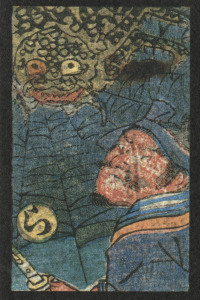
Figure 2-10-001
Below are some reproductions of obake karuta, or “monster cards” from an assortment marketed in Japan in the early 1800s. This kind of game was reportedly played well into the twentieth century. On each of the cards, one of the Japanese language’s forty-eight kana syllables (generally consisting of either a single vowel, or a consonant-vowel combination) appears inside a circular inset. For example, this card (Fig. 2-10-001) features the syllable RA, which is the first one in the name Raikō. According to legend, the warrior MINAMOTO no Raikō (944–1021) successfully slew a gigantic “earth spider” (tsuchigumo) that had been responsible for devouring many humans. On the face of the card, the samurai and the spider glower at each other before their impending confrontation.
This next obake card (Fig. 2-10-002) shows the syllable I, for INARI. Folk wisdom in Japan regarded foxes (kitsune) as prone to all sorts of mischief. For protection, the best bet was to offer prayers to Inari, a deity of the rice harvest. Notice, in the background, a rice bale as well as a streak of foxfire, the latter being a bioluminescent phenomenon that Japanese as well as Westerners have historically associated with foxes, perhaps on the basis of the animals’ nocturnal habits and native cunning.
TA (Fig. 2-10-003) is for TANUKI. “Badger” or “raccoon-dog” is the standard English translation for this species of furry mammal (Nyctereutes procyonoides is the Linnean classification) indigenous to Japan. Along with magical powers of transformation rivaling those of his cousin the fox, the tanuki was popularly imagined as possessing formidably large testicles.
RO (Fig. 2-10-004) is for ROKUROKUBI. The stretchable necks of these sinuous creatures allowed their heads to wander freely about the room even as their bodies remained seated. According to popular lore, the pleasure quarters was home to many such rubbernecks, one of whom appears on the game card in the guise of a courtesan—although her free-floating head and grotesque habit of licking the lamp oil give the ruse away. A rokurokubi appears also on this poster (Fig. 2-10-005) for Daiei’s 1968 film Yōkai hyaku monogatari (A hundred yōkai stories), and again on a similar poster (Fig. 2-10-006) for Yōkai daisensō (The great yōkai war), its sequel of the same year.
O (Fig. 2-10-007) is for OKI, or “offshore.” Marine spirits were generally known as ship ghosts (funayūrei). Such ghouls were thought to sink seafaring vessels by begging water from, and then turning around to waterlog, their crews. The best defense, according to nautical lore, was to make sure the ghostly visitors were given bottomless scoops.
YO (Fig. 2-10-008) is for YOTSUYA KAIDAN. In the celebrated kabuki play of this name, the ghost of O-Iwa torments her murderous husband by revealing her ghastly visage from inside a paper lantern. The powerful poison that the husband gave to O-Iwa disfigures her face even in death.
YU (Fig. 2-10-009) is for YUKIONNA, the Snow Woman. Her pale beauty belies an ability to kill with a puff of her frosty breath. The Snow Woman is typically pictured with long white robes and flowing hair.
CHI (Fig. 2-10-010), finally, is for CHŌCHIN OBAKE. In premodern times, popular belief in Japan held that paper lanterns, like umbrellas and sandals, might take on a life of their own once their household utility had expired.
Around the turn of the eighteenth into the nineteenth century, one convenient and enjoyable way of testing one’s store of monster knowledge in Japan was the game of obake karuta [VISUAL SIDEBAR 10: Card-Carrying Spooks]. Obake is another word for bakemono, or shape-shifter, while karuta derives from the Portuguese name for cards, which European visitors had brought to Japan in the late sixteenth century. Players of obake karuta competed to snatch up colorful monster cards matching clues read aloud by a designated master of ceremonies. At the end of the game, the individual or team who had accumulated the greatest number of cards—there was a total of forty-eight cards, one for each “letter” of the Japanese syllabary, plus a sort of joker—was declared the winner. The marvelous creatures that stared up at players from the picture cards derived from many sources, including indigenous folktales, classical literature, popular drama, Buddhist iconography, ancient Chinese lore, and contemporary urban legend.
The same principles of multiplication and division that fueled eighteenth- and nineteenth-century monster commerce in Japan applied also to its twentieth-century equivalents. Japanese film studios endowed the kaijū characters they created from the 1950s onward with clearly distinguishable traits and powers, from outward appearance to fighting tactics to signature sounds. Although both of them are flying creatures, to mistake Rodan for King Ghidorah would be a ghastly faux pas among kaijū devotees. Furthermore, like eighteenth-century yōkai, movie monsters (kaijū) were more than intangible phantasms. They took on a material existence and an exchange value, and could be owned, whether in the form of illustrated cards or picture books or three-dimensional figures. Although the posters and other images featured on this website are for the most part promotional materials that were not originally intended for sale, they, too, have become much sought-after commodities in the intervening decades.
The Pokémon craze that emerged in the late Nineties suggests that the twin principles of multiplication and division (or to put it another way, proliferation and classification) continue to shape Japan’s monster business. In various parts of the world, children still clamor for slick trading cards that bear images of Pikachū and his fellow “pocket monsters,” animated creatures that made their debut in Japan as Game Boy characters in 1996. Each of the cards provides vital statistics concerning the monster that it depicts, including its special powers and metamorphic abilities. Testifying to the underlying continuities in Japanese monster culture, the company responsible for creating Pokémon, Nintendō, was originally founded in 1889 as a manufacturer of gaming cards (hanafuda), which are related in origin to, and in fact look a lot like, obake karuta.
Even before the rise of motion pictures, visual spectacle involved more than still images. The stage, too, offered a memorable way of meeting monsters while remaining out of harm’s way. Over the ages, various dramatic traditions evolved in Japan, and with them different types of optical marvels for audiences to enjoy. One reason that theatergoers flocked to kabuki in the great cities of Japan during the eighteenth and nineteenth centuries was to witness stages that revolved and actors flying through the air. In the parallel tradition of bunraku (or jōruri), they could see puppets suddenly transforming from ordinary humans into frightening demons. The special effects of later kaijū eiga magicians like TSUBURAYA Eiji may have been technically innovative for their time, but they nevertheless drew upon deeper pools of creative ingenuity and were responding in their own way to a longstanding popular demand for visual trickery. Even the film posters and promotional stills that whetted consumers’ appetites for motion pictures in the twentieth century had precedents in earlier woodblock prints, which artists regularly produced to commemorate, and in a sense to advertise, the most recent plays, celebrated actors, and famous scenes of the kabuki theater.
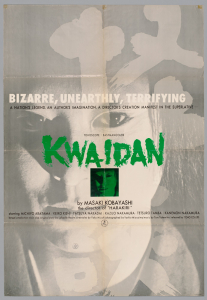
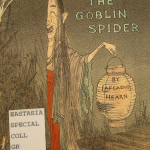
Figure 2-11-001
When Westerners began visiting Japan in growing numbers during the latter part of the nineteenth century, they found monsters all around them, both in print and on the popular stage. Some fascinated visitors sought, in turn, to share that knowledge with audiences back home.
Lafcadio Hearn, one of the earliest Western translators of Japanese monster lore, remains one of the most widely read. Giving up a modest career in American journalism, Hearn, who was British by birth, schooled in France, and had a Greek mother, arrived in Yokohama to open a new chapter in his restless life in 1890. He eventually became a Japanese citizen, adopting the name KOIZUMI Yakumo. Hearn’s abiding interest in the uncanny aspects of Japanese culture found expression in ten collections of essays that he published between 1894 and his death a decade later. The title that Hearn/Koizumi chose for his English-language rendering of the tsuchigumo legend was “The Goblin Spider.” The cover (Fig. 2-11-001) of the 1899 “Japanese Fairy Tale” edition shows, a bit misleadingly, a female ghoul holding a paper lantern, a visual reference to a different story in the same collection.
To understand the significance of Hearn’s cover image, it helps to know that lanterns, along with various other household objects, have long been associated in Japan with monsters and spirits, especially when they’re worn out and old. The most famous ghost of the kabuki stage was a character named O-Iwa, who made her debut in the 1825 play Yotsuya kaidan (Strange tales from Yotsuya), by TSURUYA Nanboku (1755–1829). At one point in the story, O-Iwa’s husband encounters the face of the wife whom he’s killed glaring accusingly at him from inside a burning lantern. Both stage technicians and woodblock artists had to deal creatively with the visual challenge. Even before O-Iwa, popular culture imagined a spook called the chōchin obake (literally, “transformed lantern”), which was little more than a paper lamp with feet and arms attached. In a pre-electrical society, a light glowing in the dark can quite easily convey a sense of the uncanny.
Long after Hearn’s demise, the expatriate’s writings would form the basis of Japanese film director KOBAYASHI Masaki’s visually stunning Kwaidan (1964; Fig. 2-11-002, Fig. 2-11-003), whose title literally means “strange tales,” or ghost stories. (The same word can also be written as, and is correctly pronounced, kaidan.) In 1965, Kwaidan won a Special Jury Prize at Cannes, not an honor that has befallen any Godzilla movie. It should be kept in mind, however, that the highbrow Kwaidan and the most cheesy of Godzilla features both emerged from the same studio, Tōhō, and that these seemingly different undertakings both relied on the same principles of monster capitalism.

Figure 2-11-004
This Japanese tie-up poster (Fig. 2-11-004) reminds us that, even in the case of art-house fare like Kwaidan, raising goose bumps was most of all a means of raising profits, at least from a corporate perspective. The larger, pallid face near the center of the image belongs to the legendary Snow Woman (yukionna), one of Kwaidan‘s many haunting characters. At the lower-left corner, meanwhile, a kneeling figure models a new brand of acrylic fiber, her traditional kimono and flowing locks visually echoing the Snow Woman’s classical elegance. The business reality that the poster encodes is that two corporate enterprises sought to benefit from the successful exhibition of Kwaidan: one of them the movie studio that created and exhibited the film, and the other a producer of (at least notionally) associated goods or services—in this case, a textile manufacturer—that piggybacked on the picture’s publicity. (The textile maker in question, Toho Beslon [now part of Toho Tenax], has no relation to the similarly named studio; despite the homophony, the two names use different written characters.)
Combining film publicity with more-pedestrian forms of commercial advertising was and remains common practice in Japan, as it is elsewhere. Tie-up posters were in fact created for some of Godzilla’s very earliest screen appearances. If you rode a Tokyo subway train in 1957, for example, you might have looked up to see a poster (Fig. 2-11-005) like this one for Godzilla, King of the Monsters!—Hollywood’s 1956 repackaging of the original Gojira—now playing in Japan as a reverse import. You might have taken pride, if you were Japanese, in the local lizard’s international “triumph,” as the poster put it, and perhaps been tempted to a movie house for another glimpse of Godzilla, this time through Hollywood’s, and Raymond Burr’s, eyes. Yet the sponsor of this particular advertisement wasn’t Tōhō, much less the film’s co-producers in America. Instead it was the Tokyo-based humor magazine Warai no izumi (Wellsprings of laughter), whose sales pitch to you and your fellow straphangers, expressed in large black characters along the right edge of the poster, consisted of the playful suggestion that “Godzilla himself would be entranced” (Gojira mo uttori suru) by the journal’s contents. Here, in other words, was eminently train-worthy reading material.
The fact that Godzilla was widely known to eat Tokyo subway cars (Fig. 2-11-006) may have enhanced the humor of the ad, but it was unlikely to send anyone scurrying for the exit. During the latter half of the Fifties, Godzilla was just as likely to greet Japanese consumers from the pages of children’s magazines and comic manga—including graphic narratives by such talented artists as SUGIURA Shigeru (1908–2000; Fig. 2-11-007)—as on movie screens. He had melted into the commercialized urban environment that he originally gained notoriety for melting.
Or not melting. Already in 1954, Godzilla had demonstrated his peculiar aptitude as a product mascot by sparing one of Tokyo’s iconic landmarks from fiery destruction. Among the handful of corporations that Tōhō’s sales department joined hands with to generate advance publicity for Gojira was Morinaga & Company (founded 1899), then, as now, one of Japan’s best-known brands of chocolate and other sweets. The business link resulted in product placement on a gargantuan scale: not of actual candy, but of a colossal rooftop advertising tower that the confectionary manufacturer had erected in the Ginza shopping district just the previous year, taking the form of a four-story-high neon globe (Fig. 2-11-008). When Godzilla—or rather, NAKAJIMA Haruo, the stuntman inside the suit—made his bull-in-a-china-shop romp through the Ginza in 1954, he was careful to leave Morinaga’s famous gleaming globe intact above the littered streetscape, as reflected in a publicity still (Fig. 2-11-009), the characters for “Morinaga Milk Caramel” prominently encircling its equator. (The Hattori Clock Tower, which stood on the opposite side of the Ginza crossing, wasn’t nearly as lucky.) In turn, Morinaga exploited the photogenic encounter between sourpuss lizard and galactic gumball by issuing a tie-up poster (Fig. 2-11-010) for both Gojira and its own caramel treats that deliberately foregrounded the epic showdown on the Ginza, from which the confectioner had emerged victorious.
The monster culture that evolved over time in Japan remained unfamiliar to most people in the West, or anywhere else outside the archipelago, until the nineteenth century. From the 1850s, however, Europeans and Americans began to arrive in Japan’s newly opened treaty ports in growing numbers. It didn’t take long for them to notice Japan’s rich visual traditions and the fondness of its people for supernatural lore, and to introduce what they’d discovered to audiences back home. Consequently, Godzilla was not the first Japanese monster to set foot on foreign soil. Woodblock prints depicting a range of fantastic subjects found their way into the hands of Western art connoisseurs over the course of the late nineteenth century, while written accounts and translations of Japanese “fairy tales” contributed to a broader Victorian fascination with the seemingly exotic cultures of the Orient. Through the essays of Lafcadio Hearn [VISUAL SIDEBAR 11: Strange Tales from a Strange Taleteller] (1850–1904) and other writers, Euro-Americans grew to know such storied creatures of Japanese folklore as the tengu and the kappa, along with humanoid marvels like the “woman of the snows” (yukionna) or the rubbernecked people known as rokurokubi, whose heads roamed from their bodies at night.
All things considered, a detailed familiarity with Japanese monsters remained a fairly rare form of knowledge outside Japan until the latter part of the twentieth century. During the century’s earlier half, Europeans and Americans who could name a single Japanese monster were the exception rather than the rule. Soon after film monsters began streaming out of Japan in the Fifties, however, the opposite became true. Embarrassingly, a 1985 poll revealed Godzilla to be one of the three “Japanese people” Americans knew best. For most English speakers, the term kaijū probably sounds foreign even today, and should therefore be placed in italics. Nevertheless, as historian Bill Tsutsui has pointed out, “zilla,” a suffix implying that something is huge in scale or awesome in impact, has become one of most popular, durable, and flexible word endings in the English language. Even at the level of everyday speech, Godzilla and his fellow kaijū have passed for quite a while as naturalized citizens.

